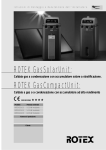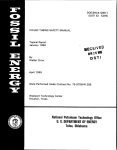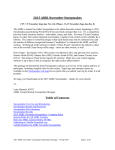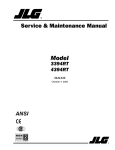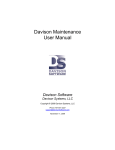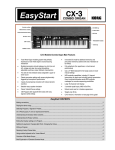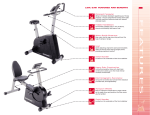Download Albrecht AE-540 User manual
Transcript
User Manual AE 540 2-m VHF Amateur Transceiver © Alan Electronics GmbH Daimlerstr. 1 k D-63303 Dreieich Contents: Regulatory notes, Declaration of Conformity..................................................................................... 3 Installation and Setup ........................................................................................................................ 4 General remarks for operating this radio........................................................................................... 4 Installation as mobile radio ................................................................................................................ 4 Connecting to DC power ................................................................................................................... 5 Rear side connections ....................................................................................................................... 5 Antenna selection .............................................................................................................................. 5 Mobile (car) antenna.......................................................................................................................... 5 AE 540 as Base Station..................................................................................................................... 6 Operation........................................................................................................................................... 6 Front panel - and microphone knobs and - keys ............................................................................... 6 Direct entry key functions (basic functions)....................................................................................... 7 On / Off, Volume and Squelch settings ............................................................................................. 7 The LC Display of AE 540 ................................................................................................................. 7 Push-to-talk button (PTT) .................................................................................................................. 8 TONE CALL 1750 Hz ........................................................................................................................ 8 Direct access to „Call“ channel.......................................................................................................... 8 Frequency search mode SCAN......................................................................................................... 8 Recalling memory-channels MR / MS ............................................................................................... 8 Microphone lock ................................................................................................................................ 8 Second level of functions (two-touch-functions)................................................................................ 9 MHz-key ............................................................................................................................................ 9 Activate repeater shift (offset) .......................................................................................................... 9 Activate Tone Squelch (CTCSS)....................................................................................................... 9 Prioriy channel „Dual Watch“.......................................................................................................... 10 Monitor key ...................................................................................................................................... 10 Complete key locking .............................................................................................................. 10 Transmit power switching Hi / Low.................................................................................................. 10 The Setup Menu .............................................................................................................................. 11 Flow-chart for the Setup Menu ........................................................................................................ 11 More about the menu steps............................................................................................................. 11 Terminating the setup menu............................................................................................................ 13 Reset to factory default settings and erasing all memories............................................................. 14 Technical informations .................................................................................................................... 14 Saving and backup of user settings ................................................................................................ 14 Connecting points for accessory items............................................................................................ 14 Mikrofonbuchse: .............................................................................................................................. 14 Ext. Speaker socket ........................................................................................................................ 14 Note to packet radio modem connection......................................................................................... 14 Programming different options (for service only after opening the cabinet).................................... 15 Technical data AE 540 .................................................................................................................... 16 Where to find service hints and documentation .............................................................................. 17 2 Regulatory notes, Declaration of Conformity General informations, Manufacturer’s Declaration of Conformity This amateur radio transceiver corresponds to the essential requirements of the EU Directive(s) 89/336/EEC (EMC), Low-Voltage-Directive 73/23/EEC, R&TTE Direktive 1999/5/EC, fulfills the harmonised European technical standards for commercially available amateur radios EN 301 783-2, EN 301 489-1, EN 301 489-15 and EN 60 950 and is marked with CE and „Alert Sign“. The original issues of our conformity declarations in their latest versions, as well as all technical documentations, may be downloaded anytime from our service-homepage www.hobbyradio.de The radio may be used under following regulatory conditions and requirements: In most European and overseas countries only licenced amateur radio operators are allowed to use this radio (e.g. in Germany § 1 „Gesetz über den Amateurfunk“, BGBL, Part III, Nr. 9022-1). Even licenced radio operators are only allowed to use the radio on frequencies, which are allocated to the amateur radio service of their licence class. In some countries restrictions are in force, where the physically switchable frequency range must not exceed the allocated frequency range limits. In such countries operators must set the programming jumpers correctly before connecting and using the radio. Exposure of persons to radiated emissions is also limited in some countries. Please respect the power limits and safety distances, if requested by the local radio authority. This radio may be used only for amateur radio purposes. Use for commercial radio purposes is subject to special licences and approvals in certain countries. The radio must be operated together with all connected accessory items in accordance to the EMC directive, so that the directive requirements are fullfilled with the complete configuration. Additonal power amplifiers may need additional harmonics filters to maintain radiation limits of unwanted spurious emissions. The amateur radio operator is responsable for compliance of the complete configuration of his amateur radio station ALAN Electronics GmbH The German or other language’s manuals (if supplied) may be different in some parts according to national special settings and requirements. Technical modifications improving the state of the art of this radio may be subject without prior notice. Technical documents are provided in their latest issue for free download on our service homepage www.hobbyradio.de or www.alan-albrecht.info Please see chapters „Amateurfunk / Amateur Radio“ for more informations. 3 Installation and Setup General remarks for operating this radio Our 2m FM transceiver AE 540 is one of the smallest available compact 12 V transceivers. It can be used everywhere provided that a suitable 12 V power supply and an external 2 m antenna is available, e.g. as base station, portable (Fieldday) station, on boats , caravans, in motor homes and – with restrictions- in road vehicles. The radio is designed for intermitting duty cycle operation- like in a typical amateur radio station setup working via repeaters (10 % transmission, 90 % receive time periods). This radio is not intended to be used for continuous transmission without allowing cooling-down periods. Longer transmission periods are acceptable with reduced (10 Watt) power setting. Please do not exhibit your radio to extreme climatic or environmental conditions, like excessive humidity, dust, high temperatures or direct sunlight. Do not open the radio unless you are able to repair SMD electronics - there are no user serviceable parts inside. For alignment and repair appropriate test instruments are necessary. The radio comes with a preprogrammed frequency range depending on the amateur radio regulations in country of sales. The tuning range may exceed the 144-146 MHz European amateur band limits where allowed. Some countries do not tolerate amateur equipment exceeding the band limits on transmitter / receiver side. Setting to various limits is internally possible by hardware jumpers. Even if the radio may be able to operate outside of the band limits 144-146 MHz, we cannot give any guarantee for keeping the specifications on out of band frequencies. Installation as mobile radio The AE 540 is designed as allround 2 m transceiver for various installations. You can either operate it at home as a base station or on boats, motor homes, caravans and cars. For installation as a mobile station in the car, a mobile mount device is enclosed. Mount the set in such a way that it is not exposed to direct sunlight if possible, as this will lead to an increase in temperature and can decrease the (set’s) working life. The set should also not be installed near a heater. Mount the set in such a way that it is exposed to as little vibration as possible. The mobile fixing device should be attached to the dashboard, the tunnel slot or to any other suitable place using the enclosed tapping screws. Do not install the set in a place where it could cause injuries in case of an accident (be particularly careful to ensure free leg movement). Take care not to damage any underlying wires during installation! Insert the radio into the fixing device. Secure the set with the large knurled screws (using the enclosed plastic washers) firmly at the required angle. Also mount the microphone fixing device using the enclosed screws in an easily-accessible place. In order to prevent interference to the vehicle electronics from transmission in the vehicle, please make sure to follow any mounting instructions by the vehicle manufacturer for radios and antennas. Important note: the end of the transition period of the new European „automotive directive“ imposes restrictions on installing and operating electronic devices in motor driven vehicles. The interpretation of the requirements of this directive for amateur radios is not quite cleared. Some authorities request that even radios, not primarily intended to be used exclusively in cars should have an additional e-approval mark, while other authorities respect a special treatment of two way radios under the R&TTE directive and EMC directive with their normal CE and alert sign marking. Some authorities request that such radios shall not be operated while the car is in motion and the engine is running. Generally, the car manufacturers have the right to issue restrictions for using two way radios in new cars (which have been put into service since 1.10.2002). Please consult the car manufacturer and ask for their installation hints, especially for EMC compatible antenna locations and DC connecting points. 4 Connecting to DC power Connect the power cable of the radio to 12 V DC power supply of your car, motor home or boat. In caravans or at home we recommend to use a suitable AC/ DC power supply, capable to deliver 6-8 A at stabilized supply voltage between 10.8 and 15.6 V. If possible, do not increase cable length and connect the power cord as close as possible directly to the battery terminals. The cable has a looped-in glass fuse for 10 A protection. If this fuse should blow, try to find out the reason, and replace the fuse only with its original value and never with wires, silver paper or aluminum foils! Connect the red wire with the positive + terminal, the black wire with the negative (-) terminal of the battery. The negative wire terminal is grounded (standard in most cars). However, do not use the car body as negative terminal and try to connect the (–) terminal of the battery instead, wherever possible! Please note that grounding of the housing may cause electrolytic and galvanic corrosion effects in steel or aluminum boats. Insulating of the radio housing and antenna may be necessary in such cases. Rear side connections Power cable assembly 12 V (13.8 V) DC External Speaker terminal (3.5 mm mono, 4-8 Ohms) Antenna socket for PL-259 (UHF) Antenna selection Mobile (car) antenna Simple reduced size magnetic base antennas or car antennas with window mount or glass mount are not the best choice for 25 W-30 W powerfull radios! Please install a powerfull VHF mobile antenna with grounded antenna foot. Keep maximum possible distance to passengers and place the antenna accorcing to the car manufacturer’s instructions as far away as possible from sensitive electronic circuits of the car wiring. Check the good ground connection to the car body of the antenna foot. Please remember that you and the passengers are in the immediate vicinity of a transmitting aerial, particularly when used as a mobile. In case you are wearing a pacemaker, and the doctor or the manufacturer of the pacemaker has recommended keeping a certain safe distance from the aerial, then please follow their instructions! Any antenna must be checked and aligned for best possible SWR (standing wave ratio). The final power amp transistor of your AE 540 is able to tolerate an SWR up to 1:2. Use a PL 259 type plug for antenna connection. A good, VHF usable quality has teflon insulation! Do not transmit without connecting the aerial and never touch the aerial during transmission! 5 AE 540 as Base Station Please respect possible restrictions in some countries (e.g. Germany), where safety distances from antennas to other persons have to be declared when certain output power levels are exceeded. For safety reasons, please do not operate this radio in high power position (25-30 Watts RF) with any kind of indoor antennas. Indoor antenna radiation may interfere with other electronic devices in the neighbourhood of your radio. Operation The operating elements, knobs and buttons are located on the microphone and front panel of your radio. Front panel - and microphone knobs and - keys • All knobs and keys are located in a way so that you can key-in directly the most important basic functions via one-touch keys. • A second level of feature settings is available as two-touch-functions. Initially, you will press the FUNC key on the microphone for less than 0.5 seconds, followed by the other function key • You can reach the Setup Menu, used for programming memory locations, DTMF and CTCSS tones incl. Decoder / encoder options, repeater shift settings, beep tones and other rarely used features like TOT (timeout-timer), by touching the FUNC key longer than 0.5 seconds! 6 Direct entry key functions (basic functions) To get to know your station we recommend that you duplicate the described steps. In this chapter you will learn the basic functions which you should know about to take part in amateur radio. It is taken for granted that you as a licensed radio amateur are familiar with basic knowledge of high frequency engineering and amateur radio regulations. This is why basic technical matters, questions of wave propagation and regulatory issues have not been considered in this manual. You can achieve all basic functions directly with the help of buttons or knobs. All directly eligible functions are marked white. On / Off, Volume and Squelch settings Before first use do not forget to connect microphone and antenna. Being as small as it is all operating elements of the AE 540 have been distributed on the front panel and the microphone according to the frequency of using them. Reception is - but without any special functions – possible without microphone. • The unit can be switched on or off by turning the combined VOL /OFF knob. When switching on for the first time choose a medium volume and turn the SQL knob to the left until you hear the background noise. • Squelch SQL has to be adjusted so that the noise just starts to disappear. In this position squelch will even be opened by weak signals, it is the most sensitive position. In case you turn squelch further to the right (clockwise) signals have to grow stronger to be switched through. The LC Display of AE 540 When switching on for the first time a frequency is shown on the LCD display in the middle of the band (145.50 MHz). This is the VFO-mode. • You can select the operating frequencies by the rotary channel selector at the front panel or the UP- / DN (down) keys on the upper side of the microphone in programmable steps (channel spacing). You may also use the direct keyboard entry on the microphone. Please follow this system: Examples: 145.7750 MHz: Enter 4 5 7 7 5 in sequence. Omit the first leading digit „1“, which is the same at all possible frequencies. Do not enter the last digit „0“, because the result is already clear after entering the „5“. So entering the last digit is not necessary. 144.8175 MHz: Enter 4 4 8 1 7 in sequence. The radio will add the last „5“ of the 12.5 kHz spacing system automatically. When switching on for the first time the programming designated for Europe is being done already in steps of 12.5 kHz. If you prefer a different frequency frame, i. e. in areas where there are not yet frequencies in the 12.5 kHz frame, adjust your radio via the set-up menu to the desired channel spacing system. 7 Push-to-talk button (PTT) You will find the PTT-button at the side of the microphone. For transmission you push this button for as long as you want to talk. When you finish talking release the PTT and your radio is automatically ready for reception again. The correct distance to your microphone is between 4 and 8 cm. Speak with the same loudness as if you were on the phone. Most of the radio beginners talk too loud into the microphone! Wait a moment after having pushed the PTT before you start talking: Your transmitter has to switch from the reception frequency to the transmitting frequency, at your partner`s side the squelch needs time to open! The delay can be between about 140 mseconds at open squelch and a max. of 300-500 msec when CTCSS coding & decoding is applied. Thus a syllable talked too early or quickly can be lost! TONE CALL 1750 Hz For repeater access most European repeaters request a tone burst 1750 Hz , appr. 1 s long. Transmit this tone by using the T-CALL key at the radio front panel. T-Call is being transmitted as long as the button is being pushed. Please do not mix up this button with the CALL/T-SQ button at your microphone! This button operates the CALL-channel described in the next paragraph. Direct access to „Call“ channel With the button CALL/ T-SQ you switch from your operating channel to a previously determined call channel and back. The manufacturer preprograms it to 145.500 MHz, the international FM-call frequency of the IARU Region I. In case you want to store a different frequency for the direct call channel please use the Set-up menu. Frequency search mode SCAN By pushing the SCAN button the radio automatically searches for frequencies which are being used by other transmitters. Before starting this process please adjust squelch correctly, otherwise searching neither can be started or stopped. Preferably SCAN is being started in VFO-mode, it will then search the complete band. As soon as SCAN finds an already occupied channel it stops there. You will then hear the radio traffic on this channel for max. 6 sec. During this time you have the opportunity to either stop scanning by touching the PTT button or by again pushing the SCAN button. If no action is taken searching will be continued after the waiting period. Searching can be done on VFO frequencies or between memory channels depending on the mode the radio is in when searching starts. Recalling memory-channels MR / MS The button MR/MS ( Memory Recall / Memory Save) switches directly to the stored channels (Memory Mode). In case you already have stored frequencies you can select these with the rotary switch. The small digit will show the memory location number 1-0 or C (flashing on free, unused memory locations and continuously on when you select a stored memory location. Microphone lock To prevent operation by mistake there is a small switch at the microphone that locks all the microphone buttons except the transmission key. This lock will be activated by turning the sunken slide switch on the microphone to the right position MIC LOCK ON. Tone call, VFO and memory buttons of the radio can still be operated. 8 Second level of functions (two-touch-functions) The following described functions all can be reached by pressing the FUNC key. Most of these second-level functions you can recognize by the orange inscription of the keys. • The function key FUNC first has to be pressed short ( less than ½ a second). The display will read FUNC. • After this the desired second-level-key will be pressed. The FUNC display will automatically disappear after a few seconds or after again pressing FUNC. MHz-key For tuning over larger frequency spans it is not convenient to use the rotary switch, it may take too many steps and too long time. Press function key FUNC. As long as y see FUNC in the display, every step of the roatary knob becomes as large as 1 MHz – so tuning from one end to the other is now very fast. Activate repeater shift (offset) Most amateur radio associations operate club-owned automatic repeater stations located on higher buildings or mountains. For transmitting via such repeaters, you will need a frequency offset between your receiving and transmitting frequency. When you press your PTT knob, the frequency of your transmitter will be shifted a certain amount versus the previous receiving frequency. Such a frequency shift is necessary to allow parallel operation of a sensitive receiver and a powerful transmitter in the repeater base station at the same time without degradation. In amateur radio systems an international standard shift of + or – 600 kHz has been established worldwide. While European repeaters always use the lower frequency for input, american repeaters often use the upper shift direction, too. In Europe you will reach all 2 m amateur vrepeaters with – 600 kHz shift. Your AE 540 allows different repeater settings in VFO mode and memory mode. • Select desired (receiving) frequency. Press: FUNC, followed by SHIFT .You will see the + icon in the display, when this function is used for the first time. • Repeat this procedure FUNC, followed by SHIFT and see the – icon • Repeating the procedure for a third time returns to initial simplex setting (without shift). Activate Tone Squelch (CTCSS) • Press FUNC , followed by T-SQ (at microphone). You will see the T icon. Now Your radio transmits a CTCSS tone parallel to Your normal modulation. You may select 38 different CTCSS tones via setup menu (next main clause). CTCSS function is only available with installed CTCSS module (will be sold as option only). • Repeat procedure FUNC followed by pressing T-SQ : display shows now T-SQ. Now not only the radio will transmit CTCSS tones, but also the receiver will decode CTCSS tones. The speaker remains silent as long as the partner station does not transmit exactly the same CTCSS code. Only when receiving a correctly coded signal, the speaker will switch on and lets You hear the conversation. • Pressing FUNC and T-SQ once more will switch back to initial setting without CTCSS. 9 Priority channel „Dual Watch“ Your radio allows monitoring two often used channels automatically in sequence. You can always check the present working frequency together with another channel of Your memory (or the Call channel). • • • Select your working frequency (VFO), e.g. 145.575 MHz Select a second channel from Memory 1-0 or Call channel Press FUNC, then PRI. Now the radio will monitor what happens on your working frequency (in the example 145.575 MHz) alternating with the later selected Memory 1-0 or Call channel. If a memory channel should have been selected as second channel, this channel may be changed even during scanning. • Stop priority scanning via short use of the PTT button or by FUNC + PRI Monitor key This key disables the squelch setting and opens the squelch as long as the key will be kept pressed. The feature is useful if a received signal becomes weak, or when the receiver is muted by CTCSS in the T-SQ setting or by DTMF decoder and you would like to hear what happens on the channel. • Press FUNC, followed by MONI and hold the key pressed. The squelch will open after a second and will remain open as long as you press the key. Complete key locking The complete key locking will lock all keys except the PTT and Moni keys. So it locks more functions compared to the lock switch on microphone. • Press FUNC and then LOCK You will see the • icon in the display. Unlock again with Func + Lock Transmit power switching Hi / Low • Press FUNC and after this for a short moment the PTT key. The display shows LOW as indication for reduced output power (about 10 watts). When transmitting, you will see less bars of the digital meter reading. • Switch back to Hi power by same sequence FUNC and PTT. The icon LOW will disappear again. 10 The Setup Menu Some more, not frequently used functions are available via selectable Setup Menu steps. You start the setup menu by longer pressing (longer than 0.5 sec) of the function key FUNC. Flow-chart for the Setup Menu FUNC key (press min. 0.5 s) SET MODE FUNC key (press min 0.5 s ) Transmit key (PTT) STANDARD MODE T-SQ MEMORY DTMF These menu steps appear only if the corresponding module(s) (CTCSS and / or DTMF) are installed. dA ON/OFF dt (DTMF) ON/OFF +,- SHIFT bP (BEEP) ON/OFF rb (Roger) ON/OFF StEP toT • Within a menu step you can select the values or actions by UP- or DOWN-keys, the rotary switch or as far as DTMF tones and repeater shift values are concerned, by keyboard. • The next menu step can be reached by subsequently pressing the FUNC key. • After the last menu step the first step will start again. • Quit the Setup Menu by pressing the PTT-key shortly. More about the menu steps T-SQ : Selection of CTCSS (continuos tone coded squelch system) frequencies is possible between 67.0 and 250.3 Hz. You may use the rotary switch or up down keys for selection. The 38 different tone frequency follow international standards and are used by most manufactures (compatible between the brands). You will need an optional CTCSS module (sold separately). The CTCSS unit can be installed by plug-in after opening the upper cabinet (no soldering or adjustment required). CTCSS is used to create closed user groups in a radio network, where all transmitting stations transmit the same low audio signal frequency parallel to microphone modulation. This is called encoder function, where the display shows T only. The receiving party can decide whether they want to listen to all radio traffic or only to radio traffic of the same user group. In that case the decoder will be activated. Speaker will be on only if the received signal carries 11 the correct DTMF tone. In that setting the display will show T-SQ. Compared to Europe, CTCSS is more familiar in USA, where most repeaters use it for selectable functions. Note: European repeater station are –in most cases- not transparent for CTCSS. This means, that received CTCSS signals are normally not transfered to the transmitter. This would require special decoders, encoders or regenerators. As a consequence, CTCSS cannot be used if a conversation will use a standard repeater not specially equipped for CTCSS. You may have a better chance if you use the highest CTCSS frequencies- test it from case to case. MEMORY : Programming of memory channels for frequent use. Before entering the setup menu, you should select the desired operating frequency in VFO mode, repeater shift and CTCSS setting. You can store a complete setting into each of the 10 memory locations. All settings can be different! • Start setup menu by FUNC longer than 0.5 sec. Memory is the first menu step. ME is flashing. A memory location number appears below ME (1-0 or C for the call channel). Free location numbers are flashing! • Select the memory location with up / down or rotary knob. • Press MR / MS at the radio front panel for saving the complete setting under this location number. A successfully saved memory location number will not flash any more and will remain continuously on! Erasing memory locations • Recall the memory channel You want to erase. • Start the setup menu step for memory (FUNC longer pressed, first setup menu step ME appears) • Press MR / MS at the radio’s front panel After erasing the memory location, the location number will flash again. DTMF: You can store up to 10 different standard numbers (similar to a phone number). Each number can have up to 5 digits. You can select one of these numbers for auto transmission, as soon as PTT will be pressed (next menu step dA, DTMF automatic), or You use one of the numbers for Your own DTMF decoder (menu step dt MF on / off, see below). • Select address (1-0) first by Up / Down or rotary knob • Enter the number (1 to 5 digits) digit by digit using the keyboard (e.g. 12345). • Store setting with DTMF key on microphone. dA: Activate (oN) or deactivate (oF) automatic DTMF transmission by means of Up / Down-selection. If activated, the previously selected DTMF number will be transmitted at the beginning of each PTT pressing. This is used e.g. for selective calling, if the other party has a decoder. Notes about DTMF: You may also manually transmit one or more single DTMF tones as digits of a „phone number“ with Your keyboard. Press and keep PTT button pressed at first. While still transmitting, enter the desired DTMF digits into keyboard. Each digit will be transmitted as long as the digit will be pressed. Most selective calling systems used in amateur radio accept manually entered numbers without problems. As a special add-on your AE 540 is even able to transmit the additional DTMF digits A, B, C and D, so together with 1-0, *, # you have 16 different DTMF tone pairs. dt If activated (DTMF oN), the speaker of your radio will be muted. If the distant party will transmit Your decoder number (e.g. 12345), the speaker will switch on and You can hear the transmission. This performs a selective calling system. 12 +,- SHIFT Selection of the repeater offset (frequency shift). Amateur radio repeaters use 600 kHz world- wide. The display will show 60, 1 digit less. The value can be changed for special purposes between 100 kHz and 8 MHz. Commercial radio networks in Europe (e.g. PMR or VHF marine radio) will use 4.6 MHz (= 4600 kHz, 460 in display). bP (Beep) switches keyboard tones on and off. rb (Roger Beep): activates or deactivates automatic-over-signal in transmitter after releasing PTT knob. st (Step): select the desired channel spacing system for better tuning. Channel spacing systems may be different among the radio services. Recently, amateur radio in Europe has applied the 12.5 kHz system (default). Note: After a reset the radio will start with 20 kHz spacing and must be reprogrammed to 12.5 kHz again. Display Channel Spacing Application 5 5 kHz steps 10 10 kHz steps 12.5 12.5 kHz steps 15 15 kHz steps For non-standard offset frequencies For non-standard offset frequencies Europe (new system), many commercial users USA (15 und 30 kHz spacing) 20 20 kHz steps 25 25 kHz steps USA, Asia, (commercial radio in Germany) Former European system, international VHF marine radio Please select the 12.5 kHz or 25 kHz spacing system for european applications.The technical parameters of this radio correspond to the system requirements of a 25 kHz spacing system with reduced FM peak deviation. You can change the channel spacing settings any time, but it is recommended to start always on an even frequency like 145.000 MHz fitting into all spacing systems (and not for example with 145.010 MHz) to avoid wrong steps or unwanted frequency offsets to (Time-out-Timer): setting for the maximum possible transmit time. If You should keep the PTT button pressed longer as adjusted in this menu step, the transmitter will switch off until You release the PTT button again. Some minutes are reasonable as setting for amateur radio. The value 10 means 10 minutes allowed continuous transmit time. The TOT can avoid accidental or unintended blocking of whole networks caused through defective PTT buttons. Maximum TOT time is 30 minutes. Note: All DTMF and CTCSS functions are only available in the setup menu, if the appropriate modules are installed inside the radio. Please note that the radio does not come with installed CTCSS and / or DTMF sub boards. The setup menu will skip menu steps belonging to uninstalled options. Terminating the setup menu Return to normal operation at any time by pressing FUNC or PTT for a short moment. The display will change to normal frequency or memory channel display. In the 5, 15, 12.5 und 25 kHz channel spacing systems you will see the kHz and 100 Hz digits smaller at the right side of the 10 kHz digits. 13 Reset to factory default settings and erasing all memories A general reset to factory default settings may become necessary when the unit shows abnormal functions or behaviour. If any malfunction should occur, try first to reset the radio, before returning it to Your distributor for repair. To perform a general reset • Switch he radio off and on again while T-Call/Shift key is kept pressed • The radio starts with factory default setting in a 20 kHz spacing system • During reset all personal settings (memories etc) are erased Note: The reset is not possible in modes 3, 6 and 7, because the user shall not have any access to the settings. If a reset in one of these modes should become necessary, open the radio, take out all jumpers and perform the reset. If the radio should now work again, repeat the customer settings (e.g. memory storings) and add the jumpers again. Technical informations Saving and backup of user settings This radio does no more need a lithium battery or any other backup medium with limited lifetime. It uses EEPROM backup technology. During each switch off procedure the CPU will load all present settings into the EEPROM and recall these information during the next power on process. The EEPROM backup does not need any electrical power for data backup and lasts for many thousands of backup procedures. Please take care that You switch the radio power at first or only via the radio’s ON / OFF volume knob and not by simple disconnecting of the external power supply (like ignition switch, power supply mains switch). Connecting points for accessory items Mikrophone wiring: 8 polig, jap. type mic socket. The microphone contains DTMF and other keys and a microcontroller for data transmission betwen microphone and radio. Please operate the radio only with the original microphone supplied with the radio, because some function can only be reached with the original keyboard. The audio input is connected via PIN 1, in series with a PTT key- wired as normally used in hand held radios which have a common wiring for MIC and PTT. If used for packet radio modems, the modem audio output should be isolated from DC via coupling capacitor in series, while the modem PTT can be connected via series resistor 2.2 kOhms to the same PIN 1. Ground is connected to PIN 8. Please do not use any other PIN of the mic socket for audio purposes. Ext. Speaker socket An external speaker should have 4-8 Ohms impedance and minimum 2-4 Watts. The socket is a 3.5 mm mono type. Inserting an extension speaker will automatically switch off the internal speaker. Note to packet radio modem connection The mic socket does not provide any audio output signal suitable for modem decoders, because the radio is only intended for normal speech transmission. However, connecting an up to 1200 bit/sec Packet Radio data modem will require an audio output signal from the receiver, which can be taken from the ext. Speaker socket only. Modulation input is available at PIN 1 of the mic socket as described in the MIC socket clause. We cannot recommend to connect modems with higher transmission data rate. 14 Programming different options (for service only after opening the cabinet) Jumper settings truth table The radio is shipped with a factory default setting to 136-174 MHz maximum possible operating range (Mode 0, no jumper inserted). Der switchable frequency range can be limited by hardware jumper setting to 144-146 or 144-148 MHz with different receiving ranges according to the following jumper setting truth table. You may solder jumper contacts or use plug-in jumpers (same jumpers are used in computer main boards, or as jumpers on ATAPI CD or hard disk drives. MODE C3 Jumper settings C2 C1 TX RX 0 - - - 136.000 - 174.000MHz 136.000 - 174.000MHz 1 yes - - 144.000 - 147.995MHz 136.000 - 174.000MHz 2 - yes - 144.000 - 145.995MHz 144.000 - 145.995MHz 3 yes yes - 4 - - yes 144.000 – 145.995 MHz 136.000 - 174.000MHz 5 yes - yes 146.000 - 174.000MHz 146.000 - 174.000MHz 6 - yes yes Slave (for commercial use only)** 7 yes yes yes Master (for commercial use only)** yes VFO mode deactivated (for commercial users, no amateur radio) * means: no jumper inserted or soldered (contact pair open). means: jumper is plugged in or soldered. * In mode 3 all keys exept the rotary swich and the PTT button are disabled. The rotary switch allows only the selection of previously programmed memory locations (maximum 10 frequency settings). This mode is designed for use as commercial radio in countries, where AE 540 is allowed to be used for PMR purposes, or for amateur use when malfunctions caused through user errors shall be excluded. For programming, start in Mode 0 (no jumper), store the desired frequency settings in one or up to 10 memory locations. Switch the radio off and insert the jumpers for mode 3. After switching on again, user can only use the pre-programmed memory locations. Even a hardware reset cannot delete these settings. ** This function is reserved for a special PMR application in countries, where this radio is allowed to be used in commercial networks. The function is described in an additional manual available from our download server under www.alan-albrecht.info or www.hobbyradio.de Safety precautions: to avoid possible problems caused through electrostatic discharges (ESD effects), please switch the radio off before opening the cabinet. Discharge all Your tools and Your hands against ground before inserting or changing the jumpers inside. There is no reset required after jumpers have been reconfigured! Just switching off and on again activates a new jumper setting. You will find the 3 jumpers just above the volume potentiometer on a Sub PCB in 90 ° angle towards front panel. Jumper C1 is away from front panel, jumper 3 is close to front panel, Jumper 2 is in the middle between the others. 15 Technical data AE 540 Frequency ranges (depending on programming) Frequency stability ITU transmission designator Allowed supply voltage tolerances Alloqwed operating temperature range DC fuse max. 136- 174 MHz +/-1.5 kHz 14KF3E with preemphasis 10.8 bis 15.6 V DC -10 bis + 55 ° C 10 A (US-Type glass fuse, inserted in cable fuse holder) 10 + 1 CALL-channel 5, 10, 12.5, 15, 20 & 25 kHz Programmable memory channels Selectable channel spacing systems Transmitter output power High LOW Transmitter spurious response Microphone sensitivity Mikrophone type max. frequency deviation for speech Tone Call 1750 Hz CTCSS (option, sold separately) DTMF selective calling (optional, sold separately) Repeater shift (repeater offset) Current consumption TX 25-max.30 Watt (tolerances 22..30W) 10 W min. 60 dB below carrier appr. 4 mV / 1 kOhm electret with keyboard default setting max. 2.8 kHz default setting appr. 2.5 kHz deviation 38 frequencies, appr. 400 Hz deviation encoder /decoder manual (keyboard) automatic (up to 5 digits) via menu - / + 600 kHz default, programmable up to 8 MHz appr. 6 A (high) appr. 4.5 A (low) Current consumption, RX Standby, squelch open, medium volume appr. 800 mA Receiver sensitivity for 12 dB SINAD Measured at 3 kHz FM deviation in 144-146 MHz range Adjacent channel selectivity 1. receiver I.F. 2. receiver I.F. Audio Output Power (at 10 % THD) Audio frequency response better than -16 dBµV appr. 55 dB (25 kHz channel spacing) appr. 45 dB (12.5 kHz spacing) 21.4 MHz 455 kHz min. 2.4 W at 8 Ohms 400Hz- 2700 Hz / -3 dB Dimensions Weight 130 mm x 35 mm x 140 mm appr. 0.5 kg 16 European 2-years legal warranty The distributor, dealer or retail shop warrants to the original retail purchaser of this product that should this product or any part of it, under normal use and conditions, be proven defective in material or workmanship within 2 years from the date of original purchase, such defect(s) will be repaired or replaced with new or reconditioned product (at the company's option) without charge for parts and repair labor. To obtain repair or replacement within the terms of this warranty, the product is to be delivered with proof of warranty coverage (e.g. dated bill of sale), specification of defect(s), to the distributor, dealer or his authorized repair center. The Company disclaims liability for communications range of this product. The warranty does not apply to any product or part there of which, in the opinion of the company, has suffered or been damaged through alteration, improper installation, mishandling, misuse, neglect, accident, or by removal or defacement of the factory serial number/bar code label(s). The warranty does not apply to accessory parts or problems caused through not authorized or not recommended accessories like batteries, external power supplies and overvoltage caused through external power supplies, light bulbs, broken antennas, broken or damaged acrylic glass windows and cabinet parts. Please contact the dealer or person where You have purchased Your AE540 amateur radio. Where to find service hints and documentation The complete technical documentation is updated regularly. You can download the latest versions of user manuals, technical documents and conformity declaration, as well as service hints or FAQ’s any time from our server under www.hobbyradio.de or www.alan-albrecht.info If You should have a problem, please have a look to the service hints or frequently asked questions (FAQ) before You send Your radio back to your distributor or service center. ©ALAN Electronics GmbH 2003 These technical documents may not be copied, completely or in parts, or used for any commercial purposes without prior written agreement by ALAN Electronics GmbH. Service-Hotline: Service-Fax Service-e-mail: Service-Download (+49) 6103 9481-30 (+49) 6103 9581-60 [email protected] www.hobbyradio.de Mailing address: ALAN Electronics GmbH Daimlerstr. 1 k or or [email protected] www.albrecht-online.de D-63303 Dreieich / Germany 17

















